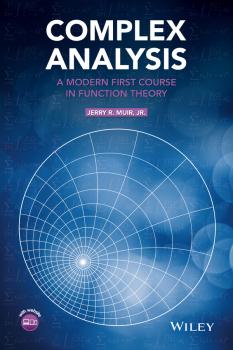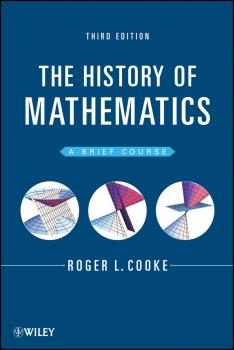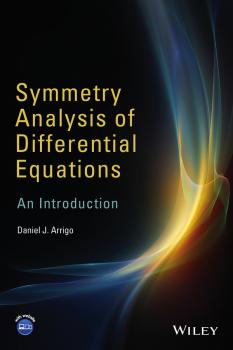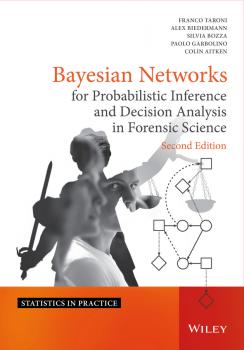ТОП просматриваемых книг сайта:
Математика
Различные книги в жанре Математика, доступные для чтения и скачиванияАннотация
A thorough introduction to the theory of complex functions emphasizing the beauty, power, and counterintuitive nature of the subject Written with a reader-friendly approach, Complex Analysis: A Modern First Course in Function Theory features a self-contained, concise development of the fundamental principles of complex analysis. After laying groundwork on complex numbers and the calculus and geometric mapping properties of functions of a complex variable, the author uses power series as a unifying theme to define and study the many rich and occasionally surprising properties of analytic functions, including the Cauchy theory and residue theorem. The book concludes with a treatment of harmonic functions and an epilogue on the Riemann mapping theorem. Thoroughly classroom tested at multiple universities, Complex Analysis: A Modern First Course in Function Theory features: Plentiful exercises, both computational and theoretical, of varying levels of difficulty, including several that could be used for student projects Numerous figures to illustrate geometric concepts and constructions used in proofs Remarks at the conclusion of each section that place the main concepts in context, compare and contrast results with the calculus of real functions, and provide historical notes Appendices on the basics of sets and functions and a handful of useful results from advanced calculus Appropriate for students majoring in pure or applied mathematics as well as physics or engineering, Complex Analysis: A Modern First Course in Function Theory is an ideal textbook for a one-semester course in complex analysis for those with a strong foundation in multivariable calculus. The logically complete book also serves as a key reference for mathematicians, physicists, and engineers and is an excellent source for anyone interested in independently learning or reviewing the beautiful subject of complex analysis.
The Development of Mathematics Throughout the Centuries. A Brief History in a Cultural Context - Brian Evans
Аннотация
Throughout the book, readers take a journey throughout time and observe how people around the world have understood these patterns of quantity, structure, and dimension around them. The Development of Mathematics Throughout the Centuries: A Brief History in a Cultural Contex provides a brief overview of the history of mathematics in a very straightforward and understandable manner and also addresses major findings that influenced the development of mathematics as a coherent discipline. This book: Highlights the contributions made by various world cultures including African, Egyptian, Babylonian, Chinese, Indian, Islamic, and pre-Columbian American mathematics Features an approach that is not too rigorous and is ideal for a one-semester course of the history of mathematics. Includes a Resources and Recommended Reading section for further exploration and has been extensively classroom-tested
Аннотация
Praise for the Second Edition «An amazing assemblage of worldwide contributions in mathematics and, in addition to use as a course book, a valuable resource . . . essential.» —CHOICE This Third Edition of The History of Mathematics examines the elementary arithmetic, geometry, and algebra of numerous cultures, tracing their usage from Mesopotamia, Egypt, Greece, India, China, and Japan all the way to Europe during the Medieval and Renaissance periods where calculus was developed. Aimed primarily at undergraduate students studying the history of mathematics for science, engineering, and secondary education, the book focuses on three main ideas: the facts of who, what, when, and where major advances in mathematics took place; the type of mathematics involved at the time; and the integration of this information into a coherent picture of the development of mathematics. In addition, the book features carefully designed problems that guide readers to a fuller understanding of the relevant mathematics and its social and historical context. Chapter-end exercises, numerous photographs, and a listing of related websites are also included for readers who wish to pursue a specialized topic in more depth. Additional features of The History of Mathematics, Third Edition include: Material arranged in a chronological and cultural context Specific parts of the history of mathematics presented as individual lessons New and revised exercises ranging between technical, factual, and integrative Individual PowerPoint presentations for each chapter and a bank of homework and test questions (in addition to the exercises in the book) An emphasis on geography, culture, and mathematics In addition to being an ideal coursebook for undergraduate students, the book also serves as a fascinating reference for mathematically inclined individuals who are interested in learning about the history of mathematics.
Аннотация
Provides a one-stop resource for engineers learning biostatistics using MATLAB® and WinBUGS Through its scope and depth of coverage, this book addresses the needs of the vibrant and rapidly growing bio-oriented engineering fields while implementing software packages that are familiar to engineers. The book is heavily oriented to computation and hands-on approaches so readers understand each step of the programming. Another dimension of this book is in parallel coverage of both Bayesian and frequentist approaches to statistical inference. It avoids taking sides on the classical vs. Bayesian paradigms, and many examples in this book are solved using both methods. The results are then compared and commented upon. Readers have the choice of MATLAB® for classical data analysis and WinBUGS/OpenBUGS for Bayesian data analysis. Every chapter starts with a box highlighting what is covered in that chapter and ends with exercises, a list of software scripts, datasets, and references. Engineering Biostatistics: An Introduction using MATLAB® and WinBUGS also includes: parallel coverage of classical and Bayesian approaches, where appropriate substantial coverage of Bayesian approaches to statistical inference material that has been classroom-tested in an introductory statistics course in bioengineering over several years exercises at the end of each chapter and an accompanying website with full solutions and hints to some exercises, as well as additional materials and examples Engineering Biostatistics: An Introduction using MATLAB® and WinBUGS can serve as a textbook for introductory-to-intermediate applied statistics courses, as well as a useful reference for engineers interested in biostatistical approaches.
Аннотация
A self-contained introduction to the methods and techniques of symmetry analysis used to solve ODEs and PDEs Symmetry Analysis of Differential Equations: An Introduction presents an accessible approach to the uses of symmetry methods in solving both ordinary differential equations (ODEs) and partial differential equations (PDEs). Providing comprehensive coverage, the book fills a gap in the literature by discussing elementary symmetry concepts and invariance, including methods for reducing the complexity of ODEs and PDEs in an effort to solve the associated problems. Thoroughly class-tested, the author presents classical methods in a systematic, logical, and well-balanced manner. As the book progresses, the chapters graduate from elementary symmetries and the invariance of algebraic equations, to ODEs and PDEs, followed by coverage of the nonclassical method and compatibility. Symmetry Analysis of Differential Equations: An Introduction also features: Detailed, step-by-step examples to guide readers through the methods of symmetry analysis End-of-chapter exercises, varying from elementary to advanced, with select solutions to aid in the calculation of the presented algorithmic methods Symmetry Analysis of Differential Equations: An Introduction is an ideal textbook for upper-undergraduate and graduate-level courses in symmetry methods and applied mathematics. The book is also a useful reference for professionals in science, physics, and engineering, as well as anyone wishing to learn about the use of symmetry methods in solving differential equations.
Аннотация
Die Finite-Elemente-Methode ist eine grundlegende mathematische Technik zur Behandlung von Differentialgleichungs- und Variationsproblemen, die in Physik und Mechanik, im Bau- und Ingenieurwesen sowie in Elektrotechnik und Mechatronik auftreten. Das vorliegende Buch ist die vierte Auflage des bewïhrten Standardwerks der drei Autoren. Es ist speziell für Naturwissenschaftler und Ingenieure geeignet, die die mathematischen Grundlagen der Methode kennenlernen wollen. Das Lehrbuch wurde grändlich überarbeitet, zudem u.a. durch Hinweise auf unstetige Galerkin-Methoden und verschiedene Varianten von a posteriori Fehlerabschätzungen sowie Literatur- und Softwareverweise auf den aktuellen Stand gebracht.
Аннотация
Several points of disagreement exist between different modelling traditions as to whether complex models are always better than simpler models, as to how to combine results from different models and how to propagate model uncertainty into forecasts. This book represents the result of collaboration between scientists from many disciplines to show how these conflicts can be resolved. Key Features: Introduces important concepts in modelling, outlining different traditions in the use of simple and complex modelling in statistics. Provides numerous case studies on complex modelling, such as climate change, flood risk and new drug development. Concentrates on varying models, including flood risk analysis models, the petrol industry forecasts and summarizes the evolution of water distribution systems. Written by experienced statisticians and engineers in order to facilitate communication between modellers in different disciplines. Provides a glossary giving terms commonly used in different modelling traditions. This book provides a much-needed reference guide to approaching statistical modelling. Scientists involved with modelling complex systems in areas such as climate change, flood prediction and prevention, financial market modelling and systems engineering will benefit from this book. It will also be a useful source of modelling case histories.
Аннотация
Praise for the Fourth Edition «As with previous editions, the authors have produced a leading textbook on regression.» —Journal of the American Statistical Association A comprehensive and up-to-date introduction to the fundamentals of regression analysis Introduction to Linear Regression Analysis, Fifth Edition continues to present both the conventional and less common uses of linear regression in today’s cutting-edge scientific research. The authors blend both theory and application to equip readers with an understanding of the basic principles needed to apply regression model-building techniques in various fields of study, including engineering, management, and the health sciences. Following a general introduction to regression modeling, including typical applications, a host of technical tools are outlined such as basic inference procedures, introductory aspects of model adequacy checking, and polynomial regression models and their variations. The book then discusses how transformations and weighted least squares can be used to resolve problems of model inadequacy and also how to deal with influential observations. The Fifth Edition features numerous newly added topics, including: A chapter on regression analysis of time series data that presents the Durbin-Watson test and other techniques for detecting autocorrelation as well as parameter estimation in time series regression models Regression models with random effects in addition to a discussion on subsampling and the importance of the mixed model Tests on individual regression coefficients and subsets of coefficients Examples of current uses of simple linear regression models and the use of multiple regression models for understanding patient satisfaction data. In addition to Minitab, SAS, and S-PLUS, the authors have incorporated JMP and the freely available R software to illustrate the discussed techniques and procedures in this new edition. Numerous exercises have been added throughout, allowing readers to test their understanding of the material. Introduction to Linear Regression Analysis, Fifth Edition is an excellent book for statistics and engineering courses on regression at the upper-undergraduate and graduate levels. The book also serves as a valuable, robust resource for professionals in the fields of engineering, life and biological sciences, and the social sciences.
Bayesian Networks for Probabilistic Inference and Decision Analysis in Forensic Science - Franco Taroni
Аннотация
"This book should have a place on the bookshelf of every forensic scientist who cares about the science of evidence interpretation" Dr. Ian Evett, Principal Forensic Services Ltd, London, UK Continuing developments in science and technology mean that the amounts of information forensic scientists are able to provide for criminal investigations is ever increasing. The commensurate increase in complexity creates difficulties for scientists and lawyers with regard to evaluation and interpretation, notably with respect to issues of inference and decision. Probability theory, implemented through graphical methods, and specifically Bayesian networks, provides powerful methods to deal with this complexity. Extensions of these methods to elements of decision theory provide further support and assistance to the judicial system. Bayesian Networks for Probabilistic Inference and Decision Analysis in Forensic Science provides a unique and comprehensive introduction to the use of Bayesian decision networks for the evaluation and interpretation of scientific findings in forensic science, and for the support of decision-makers in their scientific and legal tasks. • Includes self-contained introductions to probability and decision theory. • Develops the characteristics of Bayesian networks, object-oriented Bayesian networks and their extension to decision models. • Features implementation of the methodology with reference to commercial and academically available software. • Presents standard networks and their extensions that can be easily implemented and that can assist in the reader’s own analysis of real cases. • Provides a technique for structuring problems and organizing data based on methods and principles of scientific reasoning. • Contains a method for the construction of coherent and defensible arguments for the analysis and evaluation of scientific findings and for decisions based on them. • Is written in a lucid style, suitable for forensic scientists and lawyers with minimal mathematical background. • Includes a foreword by Ian Evett. The clear and accessible style of this second edition makes this book ideal for all forensic scientists, applied statisticians and graduate students wishing to evaluate forensic findings from the perspective of probability and decision analysis. It will also appeal to lawyers and other scientists and professionals interested in the evaluation and interpretation of forensic findings, including decision making based on scientific information.
Аннотация
Statistical Methods for Spatial and Spatio-Temporal Data Analysis provides a complete range of spatio-temporal covariance functions and discusses ways of constructing them. This book is a unified approach to modeling spatial and spatio-temporal data together with significant developments in statistical methodology with applications in R. This book includes: Methods for selecting valid covariance functions from the empirical counterparts that overcome the existing limitations of the traditional methods. The most innovative developments in the different steps of the kriging process. An up-to-date account of strategies for dealing with data evolving in space and time. An accompanying website featuring R code and examples










